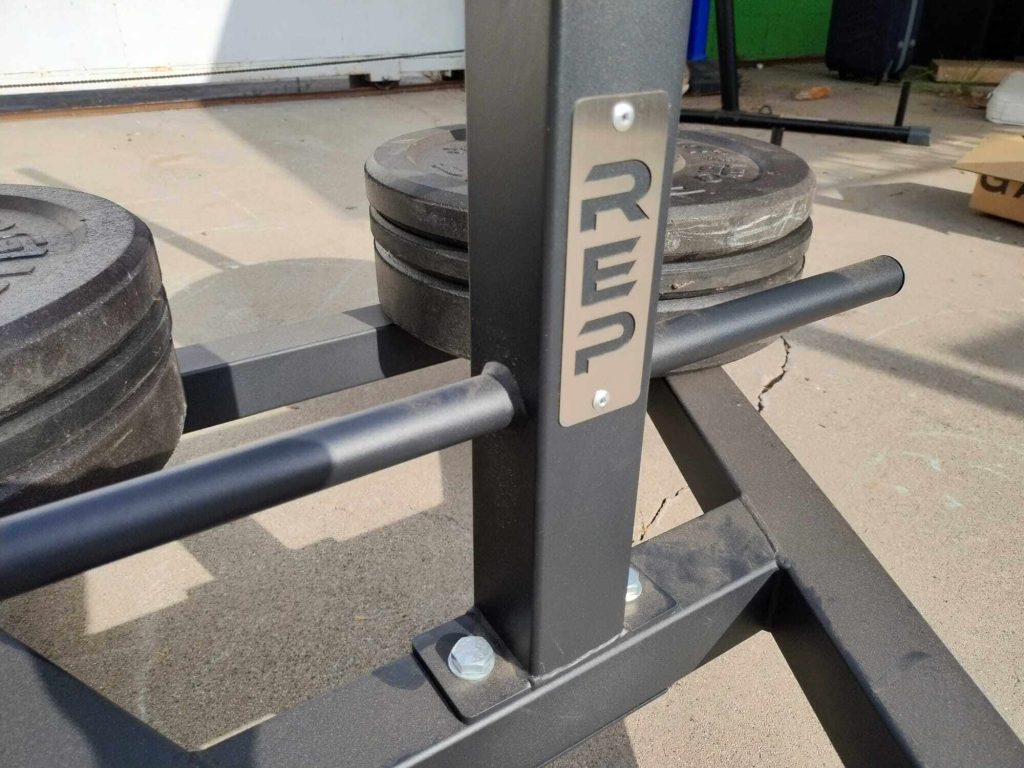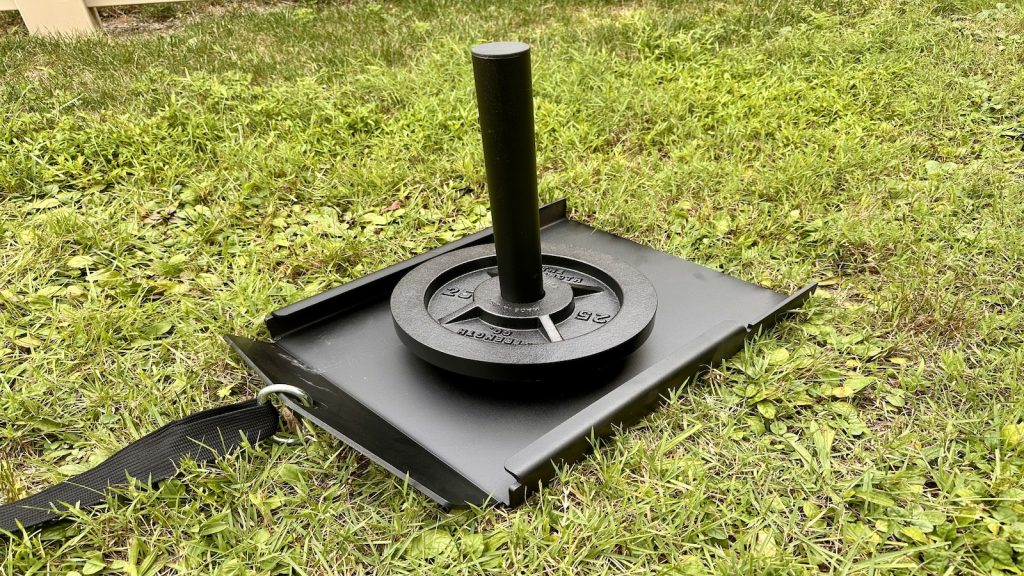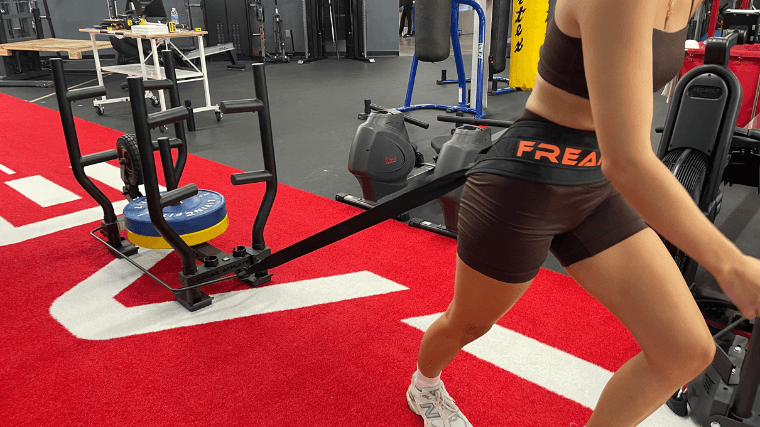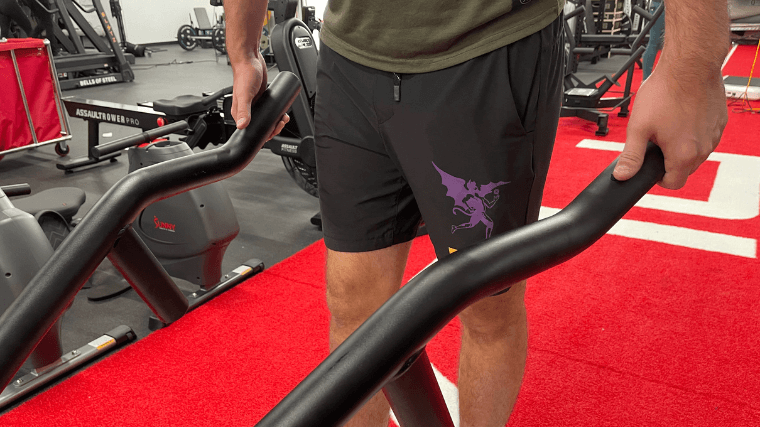Weight sleds aren’t a must-have for your home gym, but they’re a fantastic tool for strength and conditioning training. You pull, push, and, in some cases, carry them to simultaneously get in a cardio or strength workout. Like dumbbells and barbells for weight training, sleds are commonly used by football, CrossFit, and strongman athletes to build speed and explosive power.
Sleds are also expensive, and with so many options on the market, you should feel confident in your choice. Our team of personal trainers tested and researched the best weight sleds and picked their favorites to reduce your decision fatigue. From the best speed sled to a budget sled to something called the Dreadmill, our picks are below.
The Best Weight Sleds of 2025
- Best Overall Weight Sled: REP Fitness Push-Pull Sled
- Best Budget Weight Sled: Titan Fitness Power Drag Sled
- Best Treadmill-Sled Combo: Bells of Steel Dreadmill
- Best Wheelbarrow Sled: Freak Athlete Wheelbarrow Sled
- Best Sprint/Speed Sled: Shogun Sports Multipurpose Sled
- Best Prowler Sled: Rogue Echo Dog Sled
- Most Versatile Weight Sled: Torque Fitness Torque Tank M1
How We Tested and Chose the Best Weighted Sleds
The BarBend team consists of certified personal trainers, nutritionists, and competitive strength athletes. We’ve tested more than 10 different weight sleds, not to mention pieces of equipment with sled functionality, in our search for the best products in this category. You can learn more about our process by reading the BarBend Equipment Testing Methodology.
- Resistance Type: Sleds are typically loaded with weight plates, which most home gym owners already possess, or via magnetic resistance. Both are fine, though magnetic resistance is more convenient and quieter (albeit more expensive). We included both types of sleds on our list.
- Weight Capacity: When making our picks, we emphasized weight-loaded sleds capable of supporting between 400 and 500 additional pounds, which should be more than enough weight for most users.
- Durability: Since sleds get beat up more than most home gym equipment, durability was a major consideration. You’ll drag and push it across gravel, asphalt, concrete, and grass, so we looked for models with steel builds and, in particular models, tires that can handle several different types of terrain.
- Noise: Sleds are loud. If you plan on buying a sled with skis and using it on your street or in your driveway, you will make a lot of noise. When making our picks, we looked for sleds that have plastic-bottom skis (or the option to add them on) for noise reduction.
- Footprint: Sleds command a moderate amount of space, so we made sure to include a selection of sleds with smaller frames and/or sleds that can be stored vertically with a wall mount.
Best Overall Weight Sled: REP Fitness Push-Pull Sled

REP Fitness' versatile Push-Pull Sled is made from sturdy powder-coated steel that can stand up to heavy use. The sled itself weighs 75 pounds and is compatible with 2-inch Olympic iron or bumper plates.
The REP Fitness Push-Pull sled is what you picture when someone says “weight sled.” This traditional sled, which is triangular in design, supports three different pushing angles with a pair of removable uprights and pulling exercises with a trio of eyebolts on the front. It’s reasonably priced, extremely durable, and delivers exactly what you expect from a traditional sled.
If you’ve ever used a sled, you’re probably familiar with this design. You load up some of the best weight plates from your rack on two large poles on the back of the sled, then assume your pushing or pulling position. You can push the sled using the two vertical poles (which keep you more upright) or bend over to use the two vertical bars attached to the front of the sled.
Our tester, BarBend editorial member and certified personal trainer Alex Polish, scored the sled’s functionality a 4.5 out of 5. “I don’t have access to a turf surface, and I was nervous that it wouldn’t perform well (or worse, make nails-on-chalkboard sounds) on the concrete in our long driveway. No such trouble!” they say. “The small grinding sound isn’t unpleasant or scratchy by any means; no scratches on the concrete; and it even handles cracks without much interruption.”
Steel-bottomed skis are included, but you’ll need to shell out an extra $40 for skis with plastic bottoms, which are preferred when using the sled on turf, grass, or the flooring of your home gym.
Polish does note that they wish it was “easier to pull without a leash, belt, or other attachment.” Also, the included wrench for bolt-tightening was a pain. “Assembly was a 3 out of 5 for me. I didn’t love the included wrench to tighten the bolts, so I wound up breaking out my own,” they say.
Overall, though, Polish scores their workout experience with the sled a 4.5 out of 5, specifically noting how easily the sled turns on concrete.
[Related: Must Do Push/Pull and Leg Day Exercises]
Best Budget Weight Sled: Titan Fitness Power Drag Sled
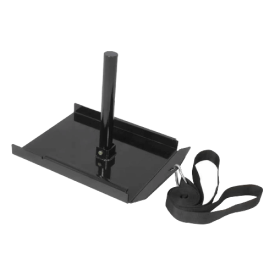
The Titan Fitness Power Drag Sled comes with a 10-foot leash to help you build explosive strength and speed. The sled itself weighs just 37 pounds, but can hold up to 500 pounds of Olympic-sized weight plates.
Pulling a sled builds immense quad strength, can strengthen the muscles around your knee joints, and bolster your coordination. We like Titan’s pull sled for its portable, minimalist design, 10-foot leash, and reasonable price tag. A sled with a 500-pound weight capacity for under $100? Score.
The major downside? “This is solely a pull sled, meaning you cannot push the weight without really compromising your positioning,” says tester and BarBend editorial member Ben Emminger. That said, it’s worth pointing out the many benefits of sled pulls.
The sled itself is almost 2 square feet, complete with a foldable pole that you can load weight plates onto. Once loaded, you’ll grab the included nylon leash and begin pulling it by either walking backward or securing the strap to your waist (for which you’ll need a specialized belt or harness).
Emminger scored its functionality and adjustability 4.5 out of 5 and a 5 out of 5, respectively. “The loading pin was sturdy enough to hold multiple plates at once, and the lockable pinion at its base was deep enough below the bracket to not interfere with plate balance,” he says. “I had no issues with the 10-foot leash and appreciated the wide-open connection point where you clip the leash to the sled. This means you can easily clip a carabiner to the sled if you already own a harness or want to train with a shorter leash.”
Without plastic skis, Emminger recommends this sled for turf or grass workouts. “The sled pulled smoothly across turf and grass, but the steel silhouette does make for a loud workout tool when used on concrete or asphalt,” he says.
Emminger scored his overall workout experience with the sled a 4 out of 5. “The sled is plenty durable given its 11-gauge steel makeup, and I do appreciate how easy it is to break the profile down for easier storage and portability,” he says. “However, I do wish there were skis at the bottom of the sled that would allow for easier sliding across rougher terrain. It can get really noisy when pulled on concrete.”
Best Treadmill-Sled Combo: Bells of Steel Dreadmill
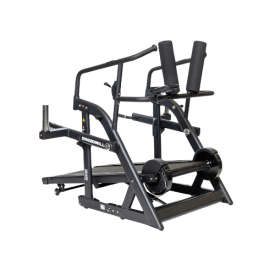
This three-in-one machine operates as a manual incline treadmill, farmer walk, and sled push. Utilize its magnetic resistance to amp up the challenge, then fold it up to clear up some floor space when not in use.
Don’t pass out from sticker shock just yet. The Dreadmill is a treadmill first that lets you mimic sled pushes, sled drags, and farmer’s carries — so you’re getting a multi-functional cardio machine. Is this machine for everyone? No. However, if you want a machine that uniquely marries resistance training and conditioning, this may be the product for you.
Let’s start with what we liked. The Dreadmill earned high marks for its design and build — 4.5 out of 5 for construction, 4.5 out of 5 for durability, and 4 out of 5 for assembly. “All together, assembly took two hours,” our tester said. “Everything came well packaged in one large box. You might want to have a hand truck available to move it to where you want to assemble it.” Our tester does note that it may be helpful to have a friend help you assemble it, though it’s not necessary.
Let’s focus on the sled feature since that’s why you’re here. It’s OK. We like that you can lean your full weight into the shoulder pads and that the manual treadmill lets you walk and run more fluidly at your own pace. Conversely, people over 6 feet may have trouble fitting into the frame comfortably.
[Related: Sled Push Alternatives]
Most notably, another one of our testers says that the push sled resistance is just too light. “The reality is, the resistance isn’’t great,” they say. “If you’re just getting this to replace sled pushes, this isn’t it.” That said, our tester notes that this machine has other functions that make it worth the price, namely that the Dreadmill is excellent for sled drags (walking backward).
Overall, the Dreadmill is a great training tool for increasing your daily step count and adding load to your walks. However, if you’re looking for a pure sled to push, we suggest looking elsewhere.
Best Wheelbarrow Sled: Freak Athlete Wheelbarrow Sled

Perform sled pushes and sled pulls before taking advantage of this versatile profile's wheelbarrow functionality, which can help strengthen your core and forearms. Also cool? It can fold up vertically when not in use.
Freak Athlete’s unique design lets you push and pull this sled and carry it like a wheelbarrow to target different muscles and improve grip strength. “This thing is so fun,” says our tester, BarBend editorial member Rosie Borchert, who pushed, pulled, and wheelbarrowed her workout on our indoor turf track. It comes pre-assembled (mostly), includes weight spacers and a strap (for pulling), and supports four pushing positions.
There’s a lot to like about this sled, specifically in how it allows you to work a variety of muscle groups, from the quads, glutes, and hamstrings to the forearms and core. You can push it in four unique positions (high and low with a vertical or horizontal grip), you can move it like a wheelbarrow thanks to the foldable wheel, or you can use the included strap to drag it. Versatility scored a 5 out of 5.
One feature we love is that the sled is encased by a thin metal rail. You clip the strap to the rail, and then you can move freely around the sled to change direction instead of having to unclip or turn the sled around.
The handles and wheels are easy to clip in and out and adjust. When you’re done using the sled, you can fold the handles inward and store the sled vertically. “Adjusting the handles from their push functionality to a wheelbarrow took maybe 10 seconds, it’s super easy,” says Borchert who gave adjustability a 5 out of 5. As a bonus, the Wheelbarrow Sled has additional wheels that make transporting it a breeze.
This sled comes pre-assembled, save for the wrap-around rail. You’ll spend just minutes putting this together, and all the necessary tools are included.
The sled costs around $400, though it’s occasionally on sale for roughly $300. That’s a nice discount, but it’s still more than many people are probably willing to pay for a specialty piece of equipment. Also, the plastic-bottom skis (which can be used on most surfaces) must be replaced every two years on average.
Best Sprint/Speed Sled: Shogun Sports Multi-Purpose Sled

This Shogun weight sled prides itself on its compact profile. It's tough as hell, too, with a body forged from powder-coated carbon steel and 11-gauge steel posts. The sled also comes with a set of pre-installed UHMW skis.
Sled work is common among athletes looking to increase their power production. Sprinting against a load builds your running muscles in the exact manner you intend to use them. The Shogun Multi-Purpose sled is an excellent pick for folks looking to run speed and sprinting drills with a sled. It’s compact, has minimal-friction skis, and can be used in both push and pull workouts.
The skis on the sled have plastic bottoms, so they can be easily dragged across various surfaces, such as concrete, grass, and turf without making too much of a racket. It’s constructed with 11-gauge steel and has four post holes, so you can easily move the handles to the other side of the sled to change direction. The included plastic skis work to reduce unwanted sound when dragged across gravel or the floor of your garage gym.
But this multi-sled is expensive. If you want the belt, leash, and wrap-around rail — which allows you to easily change direction when pulling the sled — you’ll need to shell out an additional $200. Some folks may dislike the small size of the sled, though that’s a personal preference and doesn’t affect its functionality.
Best Prowler Sled: Rogue Echo Dog Sled

The base of the Rogue Echo Dog Sled is a single piece of 0.25-inch plate steel with only four welds, making it one of the most compact and efficient weight sleds we've come across. Don't discount its toughness, though — the 17-inch weight post has an impressive load capacity of 450 pounds.
Rogue’s Echo Dog Sled is our pick for the best prowler sled thanks to its design and construction. The Ohio-based company is known for its manufacturing quality, and the Echo Dog Sled is a good example why. We admire how it’s made from a single piece of 0.25-inch steel with welding marks only on the corner sockets of the upright poles.
You can purchase plastic skis, which reduce the friction felt during push and pull exercises. However, those will cost an additional $70, and some reviews note that they wear out relatively quickly. As such, we’d recommend using this sled on grass or turf rather than concrete.
The sled only comes with two push poles. Anything else you may want will cost you extra, and, in familiar Rogue fashion, none of the extras are cheap. The 16-foot sled strap is $25; the 100-foot pulling rope is $115; and the Alpaca Sled pan and handle kits go for a combined $180.
Still, if you’re looking for a reliable, durable, USA-made sled that you can push and pull, Rogue’s Echo Dog will last forever. Buy once, cry once.
Most Versatile Weight Sled: Torque Fitness Torque Tank M1

Specifically designed for home gyms, the Torque Tank M1 is a versatile sled that's foldable and, thanks to its use of magnetic resistance over weight plates, much quieter than the traditional weight sled. This model even includes an optional display that provides a slew of real-time metrics.
There are two universal truths about weight sleds — they’re loud, and they require a lot of weight plates. We like the Torque Tank M1 because it eases the burden on both of those counts. First, it has wheels for easy mobility and reduced noise. It also employs magnetic resistance, so you don’t need many (or any) weight plates to apply resistance. Just bring your body weight.
Torque revamped their Tank M1 in 2023, with the biggest change being an adjustable toe bar that makes the sled easier to pull. “The front wheel is the only one that has resistance; the back wheels spin freely,” our tester says. “With the previous model, when you [were pulling the sled], the front wheel lifted off due to the position of the toe bar. It’s almost like pulling the sled was an afterthought. Now it has three positions and sticks out further, eliminating the issue.”
Let’s get into the scores. We’re giving the Torque Tank M1 a 5 out of 5 for noise since it’s among the quietest sleds we’ve tested. We also give it a 4 out of 5 for its resistance profile and its construction.
As mentioned, you don’t need a stack of weight plates to add resistance to the Tank M1, but adding a plate or two can provide more gravity to keep the tires grounded. If you’re a home gym owner, you’ve probably got a few sitting around that can serve this purpose.
Tank M1 costs $799, but that’s just for the base. Extras include a console ($79), dumbbell cradles ($35), wheelbarrow handles ($120), wall-mounted storage ($130), a phone holder ($20), a V-strap ($50), and a tow rope ($110). Of those, we’d highly recommend the wall-mounted storage system, which can help you save some space in your garage gym. We also recommend the cradle attachment — in addition to offering a bit of an extra challenge, slotting dumbbells in the cradles can help keep the front grounded.
Benefits of Weight Sleds
Weight sleds are unique. Unlike the best treadmills, which facilitate running, walking, or jogging, sleds are more of a hybrid weight-cardio tool. You load the sled up and perform either high- or low-intensity cardio. Here are a few benefits of training with weight sleds.
- Versatility: Sleds can be a great tool for warmups or as the foundation of an entire strength workout. “The sled can complement just about any training regimen or goal: it can build speed, burn calories, add muscle, and enhance endurance,” says Kate Meier, BarBend editorial member and certified personal trainer.
- Better Cardio: Cardio is any activity that raises your heart rate, and pushing or pulling a heavy sled with near-maximal effort gets the ticker pumping. Athletes, for example, will often practice sprint intervals with a weighted sled. You can also attach a belt to your waist and drag a moderately heavy sled for 10 to 20 minutes to make your normal walks more challenging.
- Build Speed: Common sense may lead you to believe that routinely sprinting against a load will enhance your speed when you eventually remove the load — and you’d be right. One study, which tested 50 high school athletes, found that groups who trained with weighted sled sprints saw greater speed gains than those who only trained in unloaded sprints. (1)
- Builds Lower Body Strength: Push or pull a sled and your legs almost immediately engage as you drive it forward or backward. While it’s difficult to track progressive overload in sled pushes/pulls compared to moves like the deadlift and back squat, sled work is still a good way to build leg strength and endurance.
How Much Do Weight Sleds Cost?
Compared to many of the best cardio machines, sleds are pretty affordable. However, you should expect to spend at least a couple hundred dollars, especially if you want a high-quality push-pull sled.
| Best Overall Weight Sled | REP Fitness Push-Pull Sled | $199.99 |
| Best Budget Weight Sled: | Titan Fitness Power Drag Sled | $97.97 |
| Best Treadmill-Sled Combo | Bells of Steel Dreadmill | $2,199.99 |
| Best Wheelbarrow Sled | Freak Athlete Wheelbarrow Sled | $299.99 |
| Best Sprint/Speed Sled | Shogun Sports Multi-Purpose Sled | $249.95 |
| Best Prowler Sled | Rogue Echo Dog Sled | $255 |
| Most Versatile Weight Sled | Torque Fitness Torque Tank M1 | $799 |
What to Consider Before Buying a Weight Sled
Buying a weight sled is like buying a treadmill in that it’s an investment that you want to spend some time thinking about. Consider the type of sled, resistance type, weight capacity, and where you plan on using it to guide your purchase. Keep reading for more details.
Sled Type
There are a few types of sleds and sled iterations, and which you choose depends on your training. Prowler sleds, for example, often features skis and a high weight capacity. Speed sleds, meanwhile, tend to be smaller and have lower weight capacities, making them better suited for sprints than power pushes (and pulls). There are also wheelbarrow sleds, which can help you target the core and forearms and strengthen your grip.
Resistance Type
Some sleds use magnetic resistance, which applies friction to a set of wheels to make pushing and pulling it harder. Most sleds require that you load it with weight plates to weigh it down. Which type you opt for depends mostly on how much you’re willing to spend and what you already own.
[Related: Best Bumper Plates]
“If I’m in the market for a weight sled, the first thing I’m looking for is the type of resistance it uses,” says BarBend expert reviewer and certified personal trainer Kate Meier. “Can you load your own weight plates, and, if so, do you already have them? If not, factor that cost on top of the price of the sled.”
Sleds that use magnetic resistance typically cost more, but Meier makes a good point in that if you buy a plate-loaded sled and don’t already own plates (metal or bumper plates are fine), you’ll need to shell out a few hundred extra dollars anyway.
Weight Capacity
How much your sled can hold is an important consideration, and one you’ll make based on the type of sled workout you plan to do. If you plan on performing sprints, then a speed sled that only holds a couple hundred pounds is fine. However, if you want to do heavy sled pushes/pulls, you’ll want to buy a power sled that can support 500-plus pounds.

“You can probably push or pull a lot more than you think if you want to get really heavy,” Meier says. “So a sled that only holds a few hundred pounds may not be enough for your sled training. But if you just want to do sled sprints and smoke some conditioning work, a smaller sled that holds less weight is just fine.”
Indoor or Outdoor Use
Also, consider where you’ll be using your sled. “If you get a metal sled to pull on the sidewalk out front, your neighbors may dislike all the noise you make,” Meier says. “Maybe a sled on wheels is better for you. You can also damage the sled on concrete, asphalt, or rocks, so be mindful of that if that’s the surface you’re working with.”
Types of Weight Sleds
There are a few types of sleds and sled iterations, and which you choose depends on your preferred sled training.
Traditional Weight Sled
“A traditional weight sled looks strikingly similar to a sled-riding sled: Two rails lined up parallel to one another with a mechanism in the middle to hold weight,” Meier explains. “It might have rings on the front or back to attach a rope to for pushing or pulling, and some models may have posts you can attach so you can do sled pushes. Traditional sleds are best for athletes who want to do a lot of pulling, dragging, and sprint work.”

Note that you may also hear about prowler sleds. There isn’t a clear definition of a “prowler” sled, but it’s the type you picture when you think of weight sleds. Prowlers typically have skis on the bottom, a triangular or square frame, two poles in the back (for pushing), and a bar or two on the front (for pulling and low-angled pushing). If its name wasn’t already an indication, prowler sleds are great tools for reaping the benefits of the prowler push.
Speed Sleds
These sleds are typically square-shaped and smaller than prowlers, usually just large enough to hold a stack of weight plates. Some models, like the Shogun Sports Multi-Purpose Sled, can be pulled and pushed, while others, like the Titan Fitness Power Drag Sled, can only be dragged. Speed sleds are meant to provide drag during sprints.
Wheelbarrow Sled
Virtually all wheelbarrow sleds can be used like prowler sleds, but they also possess one or more wheels, allowing you to hoist the back up and carry it like a wheelbarrow. Some sleds, like the M1 Tank, sell wheelbarrow handles separately for an additional cost.
“This is a great odd-object tool you can use to train moving heavy loads across distances,” says Meier. “You can really work your grip with this kind of sled as well.”
Weight Sleds FAQs
What is the best weight sled?
The answer varies depending on your goals, but we ranked the REP Fitness Push-Pull Sled as our best overall pick. It’s fairly priced, well-built, and does everything you want from a weight sled.
What muscles does a weight sled work?
“All of them. No, really. It will even work your lungs,” says BarBend expert reviewer Kate Meier. “The most obvious muscles you’ll work (and the ones that arguably get the most work) are in your legs. Your core muscles get a workout as they stabilize your body throughout the pull/push/drag/sprint. You may not think of a sled as having the ability to work your upper body, but it definitely can. All those muscles — triceps, pecs, biceps, delts, etc. — are contracted isometrically throughout the movement.”
Is it better to push or pull a weight sled?
It depends on what you want to achieve. You can push more weight than you can pull, and doing so will build your posterior chain (glutes, hamstrings, and back). If you’re walking for weight loss, pulling a weighted sled is a great way to add moderate resistance and increase the intensity.
Do sled pulls build glutes?
Sure, but we’d actually recommend sled pushes for developing the glutes. The glutes activate more when pushing your legs and body forward.
Are sled pushes bad for your back?
If you’re predisposed to back issues or have an existing back issue, always consult your doctor before strength training. That said, sled pushes aren’t as taxing on the upper body and don’t put your back muscles or spine in any disadvantageous positions, so you shouldn’t worry too much about randomly tweaking your back.
References
- Cahill MJ, Oliver JL, Cronin JB, Clark KP, Cross MR, Lloyd RS. (2019). Influence of resisted sled-push training on the sprint force-velocity profile of male high school athletes. Scand J Med Sci Sports. 30(3):442-449.



